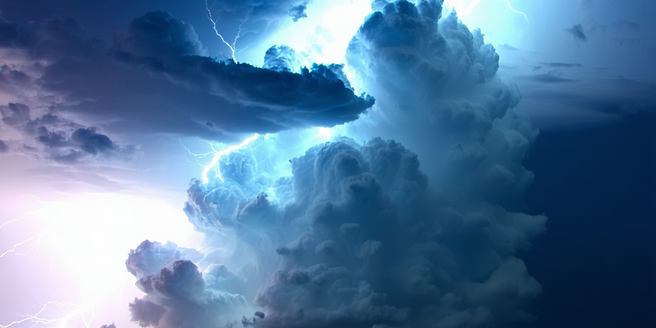
Understanding the Basics of Lightning Discharge
Lightning is a sudden electrostatic discharge that occurs during a thunderstorm. To understand the basic mechanism, we start by examining the charge separation that occurs within a storm cloud. Typically, the upper region of the cloud is positively charged, while the bottom accumulates a negative charge. This disparity creates an electric field. When the field’s strength overcomes air’s insulating properties, a discharge occurs. The discharge equalizes the charges, creating a flash of light or lightning. Enormous energy is released, heating the air almost instantly, and causing a shockwave that manifests as thunder. Understanding these basics is essential to analyze more complex phenomena surrounding lightning.
Types of Thunderstorms and Their Role
Thunderstorms vary significantly, ranging from simple single-cell storms to complex multi-cell clusters and powerful supercells. Single-cell storms are often short-lived, whereas multi-cell clusters can last for hours, bringing heavy rain. Supercells are the most severe and can produce large hail, strong winds, and tornadoes. Understanding these differences is crucial for meteorologists. Each type plays a critical role in lightning production. The dynamics within these storms control charge distribution and electric field development. Knowing the type of storm helps predict lightning patterns and potential lightning-related hazards, thereby aiding in risk assessment and safety measures during severe weather events.
How Electric Fields Cause Discharge
Electric fields within a thunderstorm cloud are a fundamental aspect of lightning formation. Charge separation due to different updrafts and downdrafts leads to the development of these fields. When the potential difference across a field is substantial, it can overcome the insulating properties of air, leading to an electrical discharge. This process usually starts with a stepped leader from the cloud seeking a path to the ground or the opposite charge within the cloud. The interaction between these fields and the resulting discharge has been a subject of extensive study, providing insights into storm electrification and lightning propagation.
The Role of Ionization in Lightning Formation
Ionization is key to creating a conductive path for lightning. Within a thunderstorm, the intense electric fields can ionize air molecules, turning them into charged particles. This process transforms non-conductive air into a plasma state. The plasma not only conducts electricity but also heats the surrounding air, causing it to expand rapidly. Ionized air further intensifies the electric field, promoting further ionization in a cascading effect. This pathway facilitates the initial stage of a lightning strike, known as the stepped leader. Understanding ionization aids in predicting lightning and devising protective measures, crucial for both scientific aviation endeavors and ground-based safety.
Step Leaders and Streamers: Key Players
In the fascinating dance of lightning formation, step leaders and streamers are crucial actors. Step leaders are the initial descending paths of ionized air that create a channel for lightning. They move in discrete steps towards the ground or another opposite charge. As they approach, they invoke streamers—positive charge channels rising from the earth or other objects. When a step leader connects with a rising streamer, a conductive path is completed, allowing a powerful return stroke, which we perceive as a lightning bolt, to occur. These interactions are vital to understanding lightning’s unpredictable path.
Measuring and Analyzing Lightning Events
Lightning events offer valuable data on storm activity and atmospheric conditions. The measurement involves detecting electromagnetic pulses generated by lightning strikes using ground-based sensors and satellites. These systems provide insights into strike frequency, intensity, and location. Furthermore, lightning data can help in aviation safety by predicting hazardous weather. Advanced analysis techniques, including high-speed cameras and lightning mapping arrays, facilitate detailed examination. This data is crucial for improving weather forecasts, advancing our understanding of storm dynamics, and developing better safety protocols. Through continuous monitoring and study, researchers aim to unravel the complex dynamics of lightning, paving the way for improved prediction and mitigation strategies.
